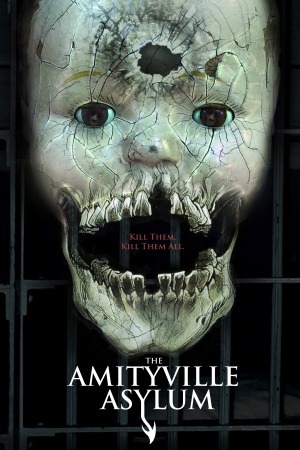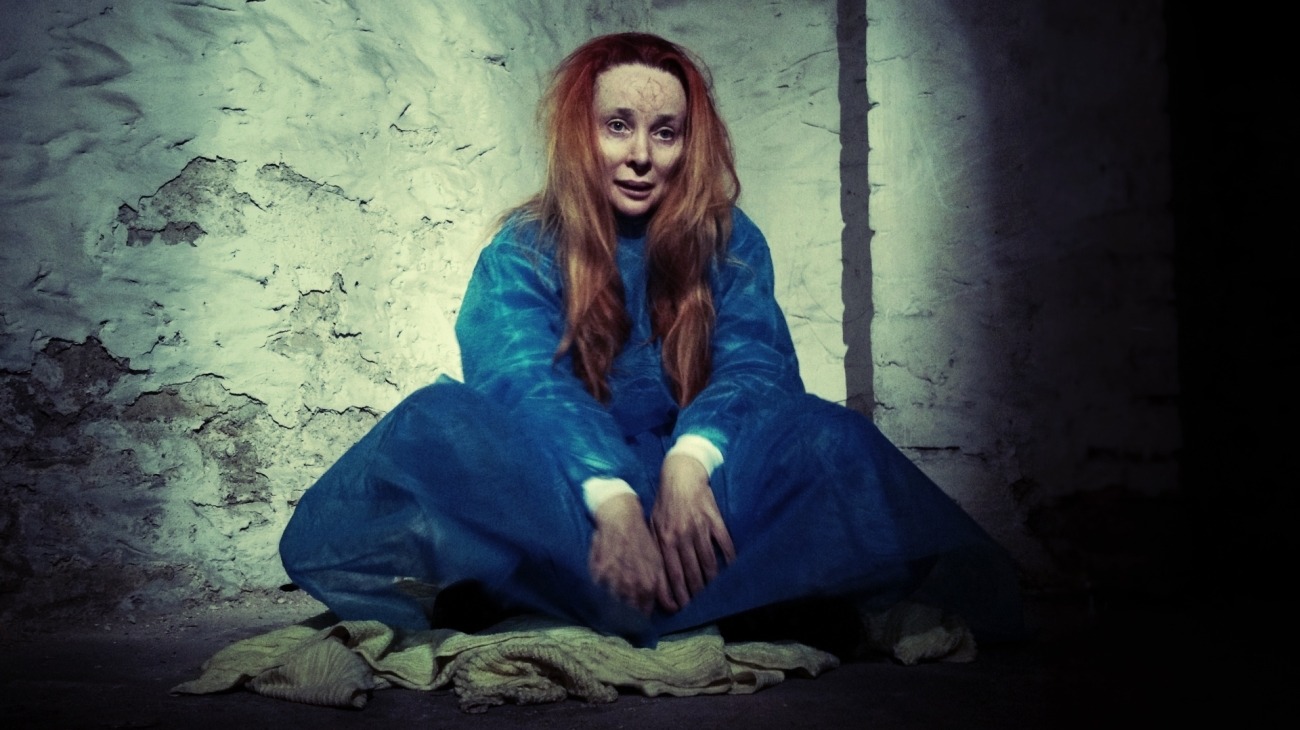
Greetings from Amityville! - It's a madhouse
Not that The Amityville Asylum set out to prove that you can make a bunch of clichés seem marginally less tired if you blend them with a bunch of other clichés, but that's kind of the net effect. The second in the suffocating wave of direct-to-video Amityville films that was inaugurated by The Amityville Haunting in 2011 is, if if nothing else, a damn sight better than that film ever threatened to be. Still not "good", you understand: it's plagued by writer-director Andrew Jones's awesomely flat dialogue, in which characters describe exposition with beautifully leaden prose that sounds like a bunch of first graders were asked to do improv for the very first time.
It's also hampered considerably by the fact that it's British, though it's really not very fair to hold that against it, I suppose. Still, titling the film The Amityville _____ does tend to demand that the film be set in Amityville, New York (he said, blithely ignoring that four films of the original eight in the franchise were about haunted trinkets traveling to California), which in turn does tend to demand that the characters be American. And this results in some splendidly awful performances, particularly from lead Sophia Del Pizzo, as broke 25-year-old Lisa Templeton, recently hired as a night shift janitor at the High Hopes mental hospital in Amityville. The dialogue Lisa is stuck with would be a chore for anybody (there's a lot of "have you heard about how there was a haunted house right here in Amityville? A man named Ron DeFeo Jr. shot and killed his family. Later it was the subject of a nationally-prominent story when a family not to be named for legal reasons fled after only 28 days" style writing), but Del Pizzo's additional handicap of having to maneuver her way around an American accent magnifies the problem by making Lisa sound mush-mouthed and slow-witted.
And then there's the matter of Delaney (Lee Bane), the older, more grizzled janitor who shows Lisa around and alludes to all of the horrible things that go on in the hospital, and especially in that shadowy corridor known as Ward X. Who, with a name like Delaney, naturally speaks with a thick Eastern European accent, which I presume is not the Welsh-born Bane's own (for that matter, wouldn't Welsh have been a better fit for a "Delaney"?).
The material of the plot is, for its own part, genial "spooky insane asylum" boilerplate, which ends up feeling oddly refreshed by being cross-bred with the traditional Amityville material of massacred Native American grave sites forming unhallowed ground on which all sorts of terrible things happen (the Amityville boilerplate is not refreshed; if anything, it feels even more stupid here). For, naturally enough, High Hopes was built on the lot at 112 Ocean Ave, after the notorious house was razed to the ground - a conceit that reveals a whole lot of ignorance of a whole lot of things, raising the question to me most urgently of how they got the zoning to build a mental hospital in the middle of a residential street - though most of what happens isn't necessarily paranormal at all.
For that matter, most of what happens isn't necessarily scary at all. The first two acts of the 88-minute film barely touch on anything beyond the threadbare notion that mental hospitals are obviously scary, because crazy people live there, and Lisa keeps jumping at things for no reason other than being overly keyed-up from her initial tour of the facilities, particularly the violent criminals wing. It's not particularly atmospheric, with the cheap digital cinematography capturing things with more clarity than lighting texture: even the dark patches, which are there in defiance of all sense other than "spooky old buildings gotta be dark", feel somehow too shiny and digital. I will concede that Andrew Jones's score - not, it seems, the same Andrew Jones who wrote and directed the film, and now I have this image of Wales as being overrun by hundreds of thousands of men all named "Andrew Jones" - is at least persistent in creating an overall sense of things being jarring and tense, and frequently gives the film a little tickle that neither the story, the images, nor the characters are able to achieve.
I appreciate, at least, that when the film trots out the inevitable "this person wasn't an employee, they were a PATIENT!" twist, it's done in a completely different way and for different reasons than I'd supposed from the start. And while the direction it takes the standard Amityville mythology is altogether ludicrous horseshit - white worshipers of an ancient Indian devil cult using the Ocean Ave. property as a psychic power point, that old chestnut - it has the charm of being different from the usual demonic possession shtick.
It's still a tacky, cheap, garbage movie, of course; direct-to-video 2010s horror could be nothing else. But at least it's got some verve and personality, of which The Amityville Haunting had neither, and for craven, mercenary no-budget cash-in filmmaking, I think that's what we get to hope for.
Reviews in this series
The Amityville Horror (Rosenberg, 1979)
Amityville II: The Possession (Damiani, 1982)
Amityville 3-D (Fleischer, 1983)
Amityville 4: The Evil Escapes (Stern, 1989)
The Amityville Curse (Berry, 1990)
Amityville 1992: It's About Time (Randel, 1992)
Amityville: A New Generation (Murlowski, 1993)
Amityville Dollhouse (White, 1996)
The Amityville Horror (Douglas, 2005)
The Amityville Haunting (Meed, 2011)
My Amityville Horror (Walter, 2012)
The Amityville Asylum (Jones, 2013)
The Amityville Playhouse (Walker, 2015)
Amityville: Vanishing Point (Greenberg, 2016)
The Amityville Terror (Angelo, 2016)
Amityville: No Escape (Couto, 2016)
Amityville Exorcism (Polonia, 2017)
Amityville: The Awakening (Khalfoun, 2017)
Not reviewed at this time
Amityville Death House (Polonia, 2015)
The Amityville Legacy (Ferguson and Johnson, 2016)
Amityville: Evil Never Dies (Ferguson, 2017)
It's also hampered considerably by the fact that it's British, though it's really not very fair to hold that against it, I suppose. Still, titling the film The Amityville _____ does tend to demand that the film be set in Amityville, New York (he said, blithely ignoring that four films of the original eight in the franchise were about haunted trinkets traveling to California), which in turn does tend to demand that the characters be American. And this results in some splendidly awful performances, particularly from lead Sophia Del Pizzo, as broke 25-year-old Lisa Templeton, recently hired as a night shift janitor at the High Hopes mental hospital in Amityville. The dialogue Lisa is stuck with would be a chore for anybody (there's a lot of "have you heard about how there was a haunted house right here in Amityville? A man named Ron DeFeo Jr. shot and killed his family. Later it was the subject of a nationally-prominent story when a family not to be named for legal reasons fled after only 28 days" style writing), but Del Pizzo's additional handicap of having to maneuver her way around an American accent magnifies the problem by making Lisa sound mush-mouthed and slow-witted.
And then there's the matter of Delaney (Lee Bane), the older, more grizzled janitor who shows Lisa around and alludes to all of the horrible things that go on in the hospital, and especially in that shadowy corridor known as Ward X. Who, with a name like Delaney, naturally speaks with a thick Eastern European accent, which I presume is not the Welsh-born Bane's own (for that matter, wouldn't Welsh have been a better fit for a "Delaney"?).
The material of the plot is, for its own part, genial "spooky insane asylum" boilerplate, which ends up feeling oddly refreshed by being cross-bred with the traditional Amityville material of massacred Native American grave sites forming unhallowed ground on which all sorts of terrible things happen (the Amityville boilerplate is not refreshed; if anything, it feels even more stupid here). For, naturally enough, High Hopes was built on the lot at 112 Ocean Ave, after the notorious house was razed to the ground - a conceit that reveals a whole lot of ignorance of a whole lot of things, raising the question to me most urgently of how they got the zoning to build a mental hospital in the middle of a residential street - though most of what happens isn't necessarily paranormal at all.
For that matter, most of what happens isn't necessarily scary at all. The first two acts of the 88-minute film barely touch on anything beyond the threadbare notion that mental hospitals are obviously scary, because crazy people live there, and Lisa keeps jumping at things for no reason other than being overly keyed-up from her initial tour of the facilities, particularly the violent criminals wing. It's not particularly atmospheric, with the cheap digital cinematography capturing things with more clarity than lighting texture: even the dark patches, which are there in defiance of all sense other than "spooky old buildings gotta be dark", feel somehow too shiny and digital. I will concede that Andrew Jones's score - not, it seems, the same Andrew Jones who wrote and directed the film, and now I have this image of Wales as being overrun by hundreds of thousands of men all named "Andrew Jones" - is at least persistent in creating an overall sense of things being jarring and tense, and frequently gives the film a little tickle that neither the story, the images, nor the characters are able to achieve.
I appreciate, at least, that when the film trots out the inevitable "this person wasn't an employee, they were a PATIENT!" twist, it's done in a completely different way and for different reasons than I'd supposed from the start. And while the direction it takes the standard Amityville mythology is altogether ludicrous horseshit - white worshipers of an ancient Indian devil cult using the Ocean Ave. property as a psychic power point, that old chestnut - it has the charm of being different from the usual demonic possession shtick.
It's still a tacky, cheap, garbage movie, of course; direct-to-video 2010s horror could be nothing else. But at least it's got some verve and personality, of which The Amityville Haunting had neither, and for craven, mercenary no-budget cash-in filmmaking, I think that's what we get to hope for.
Reviews in this series
The Amityville Horror (Rosenberg, 1979)
Amityville II: The Possession (Damiani, 1982)
Amityville 3-D (Fleischer, 1983)
Amityville 4: The Evil Escapes (Stern, 1989)
The Amityville Curse (Berry, 1990)
Amityville 1992: It's About Time (Randel, 1992)
Amityville: A New Generation (Murlowski, 1993)
Amityville Dollhouse (White, 1996)
The Amityville Horror (Douglas, 2005)
The Amityville Haunting (Meed, 2011)
My Amityville Horror (Walter, 2012)
The Amityville Asylum (Jones, 2013)
The Amityville Playhouse (Walker, 2015)
Amityville: Vanishing Point (Greenberg, 2016)
The Amityville Terror (Angelo, 2016)
Amityville: No Escape (Couto, 2016)
Amityville Exorcism (Polonia, 2017)
Amityville: The Awakening (Khalfoun, 2017)
Not reviewed at this time
Amityville Death House (Polonia, 2015)
The Amityville Legacy (Ferguson and Johnson, 2016)
Amityville: Evil Never Dies (Ferguson, 2017)






